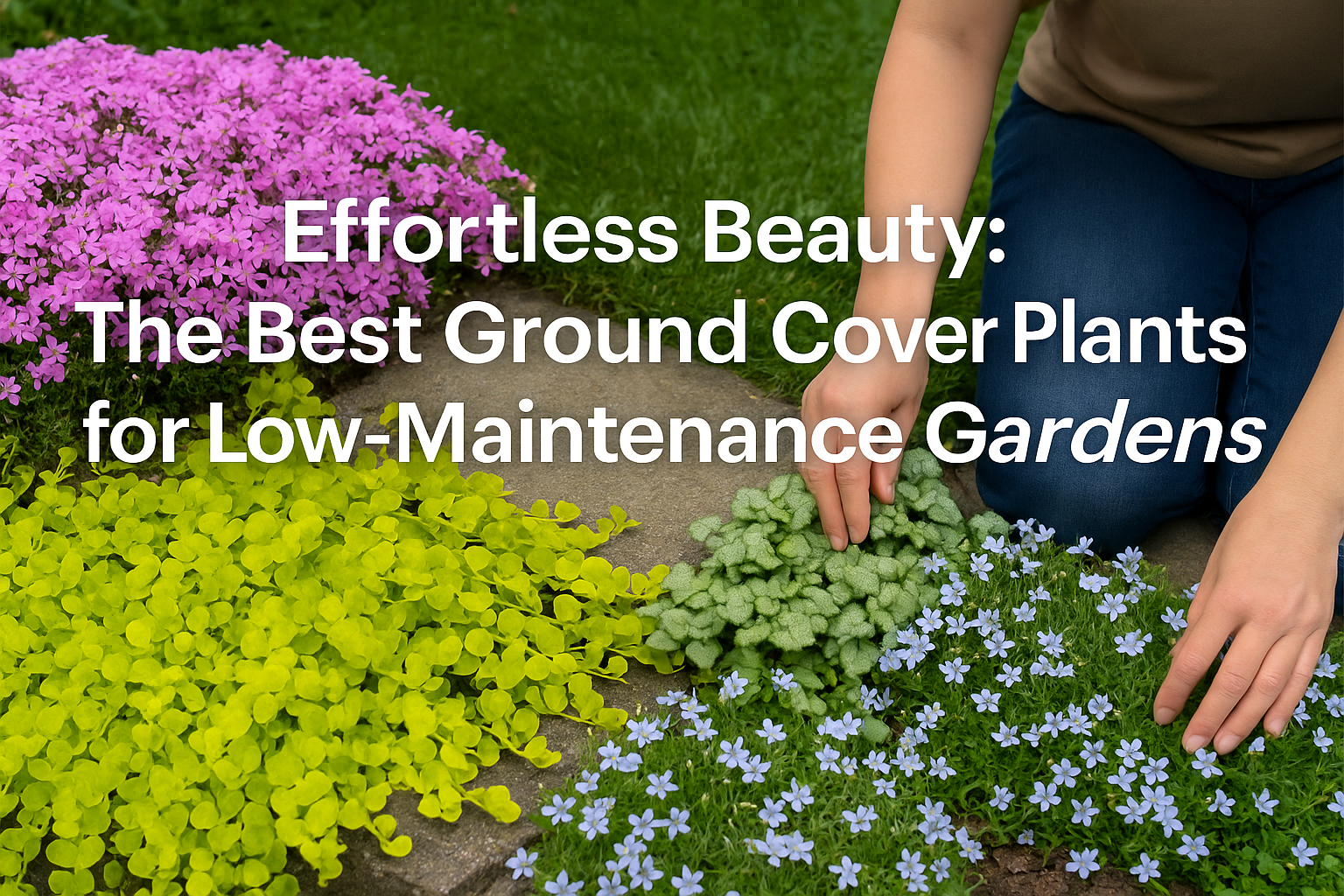If you dream of a lush, vibrant garden that doesn’t demand hours of weeding, watering, and pruning, ground cover plants are your new best friend. These low-growing, spreading plants are nature’s solution to bare patches, soil erosion, and high-maintenance turf. They add texture, suppress weeds, conserve moisture, and—best of all—look stunning all year long.
In this guide, we’ll walk you through the best ground cover plants for easy, care-free gardening. Whether you want to carpet your shady backyard, beautify a sunny slope, or fill in gaps between stepping stones, we’ve got you covered—literally.
Why Choose Ground Cover Plants?
Ground covers serve both practical and aesthetic purposes:
- Suppress Weeds: A dense ground cover prevents sunlight from reaching weed seeds.
- Conserve Moisture: These plants act as living mulch, keeping the soil cool and moist.
- Prevent Erosion: On hills or slopes, they anchor the soil with their roots.
- Add Texture and Color: Ground covers create visual interest with blooms, foliage, and seasonal variation.
- Reduce Maintenance: Unlike lawns, ground covers require less mowing, watering, and fertilizing.
How to Choose the Right Ground Cover
Before diving into specific varieties, consider these factors:
1. Sun Exposure
- Full Sun: 6+ hours of direct sunlight
- Partial Shade: 3–6 hours of sunlight
- Full Shade: Less than 3 hours of sunlight
2. Soil Type and Drainage
Some plants prefer well-drained sandy soils, while others thrive in clay or loam.
3. Climate Zone
Choose plants that are hardy in your USDA plant zone for year-round success.
4. Purpose
- Decorative?
- Erosion control?
- Pet-friendly?
- Walkable?
Best Ground Cover Plants for Sunny Spots
1. Creeping Thyme (Thymus serpyllum)
- USDA Zones: 4–9
- Sun: Full sun
- Why It’s Great: This fragrant, low-growing herb forms a dense mat and produces purple-pink flowers in summer.
- Bonus: It’s walkable and drought-tolerant, making it perfect between stepping stones.
2. Sedum (Sedum spp.)
- Zones: 3–9
- Sun: Full sun
- Why It’s Great: Also known as stonecrop, sedums are succulents with fleshy leaves and star-shaped flowers.
- Varieties to Try: ‘Dragon’s Blood’, ‘Angelina’, ‘Blue Spruce’
- Maintenance: Practically zero—ideal for dry areas.
3. Ice Plant (Delosperma cooperi)
- Zones: 5–9
- Sun: Full sun
- Why It’s Great: A dazzling ground cover with neon-colored daisy-like flowers. Highly drought-tolerant.
- Best Use: Slopes and rock gardens.
4. Dwarf Mondo Grass (Ophiopogon japonicus ‘Nana’)
- Zones: 6–11
- Sun: Full sun to part shade
- Why It’s Great: Grass-like but evergreen, this plant needs minimal mowing.
- Best Use: Borders and paths.
Best Ground Cover Plants for Shade
5. Sweet Woodruff (Galium odoratum)
- Zones: 4–9
- Shade: Full to part shade
- Why It’s Great: With star-shaped leaves and tiny white spring flowers, sweet woodruff brings elegance to shady gardens.
- Bonus: Pleasant, hay-like fragrance when dried.
6. Pachysandra (Pachysandra terminalis)
- Zones: 4–8
- Shade: Full to part shade
- Why It’s Great: A dense, evergreen carpet that spreads quickly and smothers weeds.
- Warning: Can be invasive if not contained.
7. Hostas
- Zones: 3–9
- Shade: Part to full shade
- Why It’s Great: Though not a traditional ground cover, hostas fill large shady areas with stunning foliage in green, blue, and variegated forms.
- Best Use: Under trees or around garden borders.
8. Lamium (Lamium maculatum)
- Zones: 3–8
- Shade: Part to full shade
- Why It’s Great: Silver-spotted leaves with purple, white, or pink flowers that bloom for months.
- Pro Tip: Keep it pruned to avoid aggressive spreading.
Best Flowering Ground Covers
9. Periwinkle (Vinca minor)
- Zones: 4–9
- Sun: Shade to part sun
- Why It’s Great: Glossy evergreen leaves and violet-blue blooms in early spring.
- Fast Spreader: Be careful where you plant it; it takes over easily.
10. Ajuga (Ajuga reptans)
- Zones: 3–10
- Sun: Full sun to part shade
- Why It’s Great: Rich purple or bronze foliage with blue flower spikes.
- Uses: Great for erosion control on slopes.
11. Creeping Jenny (Lysimachia nummularia)
- Zones: 3–9
- Sun: Full sun to part shade
- Why It’s Great: Vibrant golden foliage adds brightness to shady areas. Works well in containers, too.
- Note: Can become invasive if unchecked.
Best Ground Cover for Slopes and Hillsides
12. Bearberry (Arctostaphylos uva-ursi)
- Zones: 2–6
- Sun: Full sun to part shade
- Why It’s Great: Evergreen, drought-resistant, and excellent for stabilizing slopes.
- Appearance: Pink spring flowers, followed by red berries.
13. California Lilac (Ceanothus spp.)
- Zones: 8–10
- Sun: Full sun
- Why It’s Great: Fast-growing, flowering, and a favorite for pollinators.
- Note: Best for western U.S. climates.
Best Evergreen Ground Covers
14. Blue Star Creeper (Isotoma fluviatilis)
- Zones: 5–9
- Sun: Full sun to part shade
- Why It’s Great: Forms a lush carpet with dainty blue flowers; walkable and great between pavers.
15. Woolly Thyme (Thymus pseudolanuginosus)
- Zones: 5–9
- Sun: Full sun
- Why It’s Great: Soft, silvery foliage with a creeping habit and pink flowers.
- Use: Ideal for rock gardens or footpaths.
Best Ground Covers for Walkways and Paths
16. Irish Moss (Sagina subulata)
- Zones: 4–9
- Sun: Full sun to part shade
- Why It’s Great: Plush green tufts that feel like a cushion underfoot.
- Use: Between stepping stones or patios.
17. Corsican Mint (Mentha requienii)
- Zones: 7–9
- Sun: Part shade
- Why It’s Great: Aromatic, low-growing, and edible. Plus, it releases a minty scent when stepped on!
Tips for Planting and Maintaining Ground Cover
1. Prepare the Site
- Remove all weeds.
- Loosen soil and add compost or organic matter.
- Consider a pre-emergent weed barrier if planting slow spreaders.
2. Spacing Matters
- Follow plant spacing guidelines to ensure they fill in without overcrowding.
- Ground covers may take a year or two to become fully established.
3. Water Wisely
- Keep new plantings consistently moist.
- Once established, many ground covers require minimal water.
4. Mulch Initially
- Helps prevent weeds while plants are still growing in.
5. Trim and Contain
- Prune spreading varieties to maintain control.
- Use edging to keep aggressive plants in check.
Pet-Friendly Ground Covers
If you have pets that love to dig, sniff, or roll in your garden, consider these safe options:
- Clover (Trifolium repens)
- Elfin Thyme
- Blue Star Creeper
- Moss Phlox (Phlox subulata)
Avoid toxic options like English ivy or periwinkle if you have curious dogs or cats.
Ground Covers to Avoid (or Watch Closely)
Some ground covers are considered invasive and can choke out native species:
- English Ivy (Hedera helix)
- Periwinkle (Vinca major)
- Creeping Jenny (in some regions)
Always check with your local extension office or native plant society to verify if a species is invasive in your area.
Conclusion: Cover More Ground, Work Less
Ground covers offer a visually rich, low-maintenance alternative to traditional lawns and flower beds. Whether you want a solution for shade, erosion control, or walkable greenery, there’s a ground cover plant that fits your needs—and makes your garden more beautiful with less effort.
Start with one section of your garden, experiment with a few varieties, and watch your landscape transform into a thriving, low-maintenance paradise.

